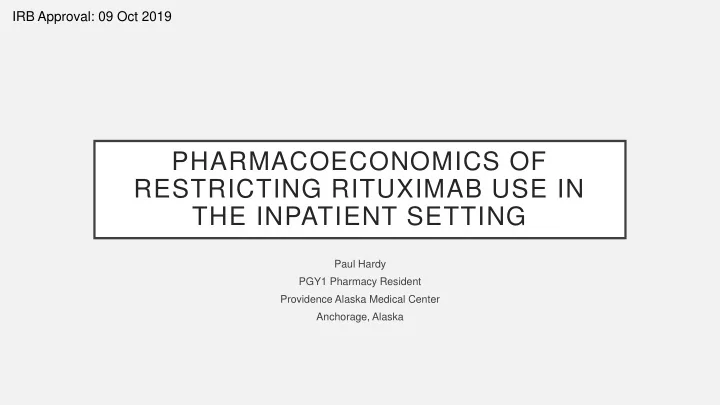

IRB Approval: 09 Oct 2019 PHARMACOECONOMICS OF RESTRICTING RITUXIMAB USE IN THE INPATIENT SETTING Paul Hardy PGY1 Pharmacy Resident Providence Alaska Medical Center Anchorage, Alaska
DISCLOSURE • Paul Hardy has no conflicts to disclose and received no funding to support this research • This research is subject to different interpretation • This presentation abides by applicable non-commercial guidelines 1
Characterize the basic differences between inpatient and outpatient billing practices for biologic medications. Differentiate between the common LEARNING indications for rituximab in the inpatient setting. OBJECTIVES Compare net costs for rituximab before and after implementation of an inpatient restriction policy for oncologic indications. 2
STUDY SITE LOCATION • Providence Alaska Medical Center • 401 bed tertiary care hospital • 12-bed oncology section of general medicine inpatient unit with dedicated nursing and ancillary staff • Lee Sheffield Infusion Center: Adjoining 15 chair outpatient infusion center • Oncologists and hematologists not directly employed by the hospital 3
PRE-ASSESSMENT QUESTION #1 1. Under which of the following billing methods is rituximab routinely reimbursed in the inpatient setting? a. Diagnosis-related groups (DRGs) b. Direct service billing c. Fee-for-service d. Outpatient Prospective Payment Systems (OPPS) e. Ambulatory Payment Classifications (APCs) 4
PRE-ASSESSMENT QUESTION #2 2. Common uses for rituximab use include: (Select all that apply) Non- Hodgkin’s Lymphomas a. b. Rheumatoid arthritis c. Thrombotic thrombocytopenic purpura (TTP) d. Post-transplant lymphoproliferative disorders e. Microscopic polyangiitis and granulomatosis with polyangiitis f. Pemphigus vulgaris 5
PRE-ASSESSMENT QUESTION #3 3. Benefits of outpatient administration of rituximab for oncologic indications includes: (Select all that apply) a. Reduced drug acquisition costs for the facility b. Significantly reduced inpatient length of stay for multidrug chemotherapy regimens c. Possibly increased volume of outpatient administrations of rituximab using 340b acquired medication 6
• Evaluate the pharmacoeconomic impact STUDY of the site policy restricting rituximab in OBJECTIVES the inpatient setting for oncologic indications 7
Graft-versus-Host Disease Posttransplant Conditions Lymphoproliferative Disorders Lupus Nephritis Oncologic Nephrologic Indications Indications Other Nephropathies Non-Oncologic Indications Hematologic RITUXIMAB TTP Indications INDICATIONS Pemphigus Vulgaris Rheumatoid Arthritis Rheumatologic Indications Wegener’s Granulomatosis Microscopic Polyangiitis 8
• Cost versus reimbursement for biologic medications in the inpatient setting • Medication billing differences in inpatient and outpatient settings • Advantageous drug acquisition costs in the BACKGROUND ambulatory setting (340b) (CONT.) • Previous data on potential benefits and safety of implementing restriction policies • PAMC restriction policy implemented September 2019 9
OBJECTIVES Primary Outcome: Secondary Outcome: Evaluate drug acquisition costs saved per Evaluate change in average length of stay in patient admission following implementation days for the inpatient population. of the site policy. 10
STUDY CRITERIA Inclusion Criteria: • ≥ 18 years of age • Billing code associated with a rituximab administration for an oncologic indication Exclusion Criteria: • Pregnant • Incarcerated • < 18 years of age • Rituximab administrations for any non-oncologic indications (auto-immune, transplant, etc.) 11
METHODS Date Range Study Group From: T o: • Data obtained by running report for all J9312 or Q5115 CPT/HCPCS codes for the study date ranges 01 Feb 31 Aug Pre-Policy 2019 2019 • Data narrowed for oncologic indication by ICD9/ICD-10 code and prescribing 01 Sep 31 Mar provider group (hematology, Post-Policy nephrology, rheumatology, etc.) 2019 2020 • 2-sided t-test to assess primary and secondary outcomes 12
STUDY POPULATION Inpatient n=26 Pre-Policy Outpatient n=17 4 Exempt Administrations Inpatient n=41 37 Admissions with Rituximab Post-Policy Restricted Outpatient n=21 13
37 inpatient administrations restricted over post-policy study period • Total rituximab cost for these admissions: $245,858.03 RESULTS Average cost savings per inpatient admission post-policy • $6,300.84 (p=<0.01) 14
RESULTS: AVERAGE LENGTH OF STAY • Pre-Policy Number of Average Length of Stay Regimen: Overall Average Length of Stay (SD) Admissions (Days) High-Dose Methotrexate + Rituximab 14 3.6 R-Hyper-CVAD 6 3.3 5.20 (2.26) TLS (emergent rituximab) 1 5 R-EPOCH 5 6.8 • Post-Policy (length of stay WITHOUT rituximab) Number of Average Length of Stay Regimen Overall Average Length of Stay (SD) Admissions (Days) High-Dose Methotrexate + Rituximab 19 4.7 4.92 (0.91) R-EPOCH 18 5.7 15
RESULTS: AVERAGE LENGTH OF STAY (CONT.) • Average length of stay difference: • 0.28 days shorter stay per patient admission in the post-policy study group (p=0.57) 16
The restriction policy reduced rituximab administrations in the inpatient setting. Average cost for rituximab per admission CONCLUSION was significantly reduced in the post-policy study group. A nonsignificant decrease in the average length of stay per inpatient admission was observed in the post-policy group. 17
Clinical/operational environment of this study Possible causes for nonsignificant findings on secondary outcome Cost savings associated with restriction policy DISCUSSION Future directions: • As appropriate and feasible, restricting biologic medication administrations for non-oncologic indications • Downstream effects of the restriction policy on patient satisfaction with the different scheduling for inpatient and outpatient delivery of chemotherapy regimens 18
PRE-ASSESSMENT QUESTION #1 1. Under which of the following billing methods is rituximab routinely reimbursed in the inpatient setting? a. Diagnosis-related groups (DRGs) b. Direct service billing c. Fee-for-service d. Outpatient Prospective Payment Systems (OPPS) e. Ambulatory Payment Classifications (APCs) 19
PRE-ASSESSMENT QUESTION #2 2. Common uses for rituximab use include: (Select all that apply) Non- Hodgkin’s Lymphomas a. b. Rheumatoid arthritis c. Thrombotic thrombocytopenic purpura (TTP) d. Post-transplant lymphoproliferative disorders e. Microscopic polyangiitis and granulomatosis with polyangiitis f. Pemphigus vulgaris 20
PRE-ASSESSMENT QUESTION #3 3. Benefits of outpatient administration of rituximab for oncologic indications includes: (Select all that apply) a. Reduced drug acquisition costs for the facility b. Significantly reduced inpatient length of stay for multidrug chemotherapy regimens c. Possibly increased volume of outpatient administrations of rituximab using 340b acquired medication 21
Recommend
More recommend